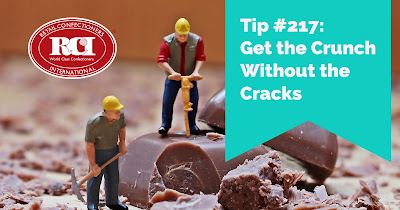Randy Hofberger of R&D Candy Consultants, LLC, is an
active member of RCI and the lead instructor for RCI’s Chocolate Boot Camp®.
This week’s post is an excerpt from his article “Crunch Without the Cracks,”
which offers eight tips to reduce cracking in chocolate-covered pretzels,
cookies and crackers.
Texture is so very important in our foods and is a large part of
the eating experience. Many of our most popular confections have a crunchy
texture and using baked goods such as cookies, crackers and pretzels is one way
to provide this. When coated with chocolate, however, there is a chance the
finished product will crack, making it less appealing to consumers.
What cause these fissures to develop? While it may seem that there
are little micro earthquakes occurring on your pretzels or gremlins attacking
the chocolate-covered cookies, one of the main culprits can be moisture
entering these dry baked goods and causing them to expand. To prevent moisture
from coming in contact with the finished product, one of the most obvious
solutions is to use packaging with a good moisture barrier. While this will
solve many of the cracking problems, there are other factors that can cause
cracking. Also, this will not help any of your products that are open to the
atmosphere in your display cabinets.
Other suggestions to reduce cracking in chocolate covered
pretzels, cookies and crackers include the following:
- Have a uniform coating. Unequal coverage will cause different contraction rates and, thus, cracking.
- Thicker coating is a stronger coating and a better moisture barrier. Coverage should be complete without pin holes, air bubbles or thin spots.
- Using a chocolate formulated to be softer will be less prone to cracking.
- Enrobed baked goods will generally have less of a heat load and
will require a gentler (less) cooling.
Good cooling tunnel conditions will have little or no air movement at
the tunnel entrance and a temperature of approximately 65ºF. Air velocity may be gradually increased to
about 700 CFM until the chocolate is set – at which time velocity may be
increased to 1200 CFM. Coldest tunnel temperatures exceed the low 50sºF. Total tunnel
time should be a minimum of eight minutes, but 12 minutes is better.
If your operation requires you to maintain consistent tunnel settings because of various product mixes, increasing the tunnel belt speed will give less total cooling and more line production. - Enrober/tunnel/feeding area relative humidity should not exceed 55%.
- Pieces to be enrobed should be room temperature or warmer (up to 78ºF).
- Pretzel and cookie packages can be opened the evening prior to enrobing. This will help them equilibrate to the atmospheric conditions.
- Rough-surfaced centers reduce cracking and the loss of the chocolate shell, e.g., salted pretzels are better than unsalted pretzels.
Stay connected with RCI
through Facebook for
more tips and inspiration dedicated to the retail candy maker. Not a
member? Click here to learn how RCI can help
you build your sweet business.

